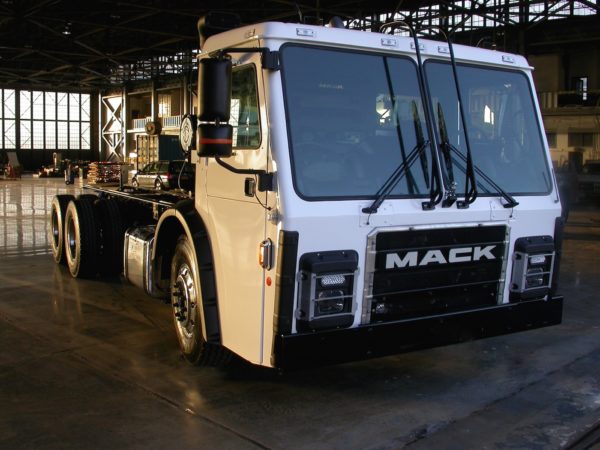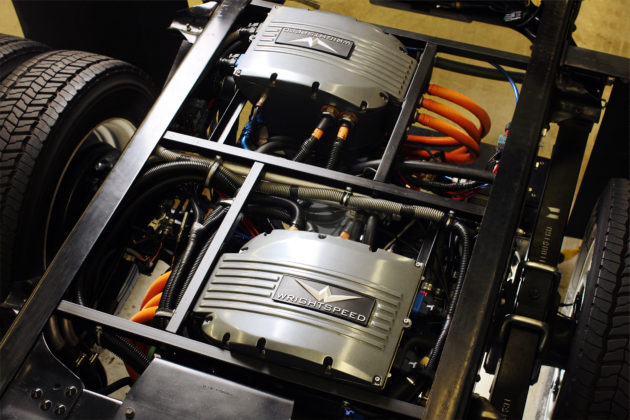A new Route forward for electrification
TORONTO, Ont. — Within five years, no one will be buying garbage trucks with diesel engines. Instead, they’ll be using Wrightspeed’s Route, a range-extended electric powertrain, according to Ian Wright, the man behind the new concept.
It’s a bold prediction, but its inventor does have some credibility. Wright co-founded electric car company Tesla and also developed the fastest street legal electric-powered car in the world, the X1. Now, he has turned his attention to the truck market, where he sees the greatest potential for fuel and maintenance savings by converting to electric power.

Wrightspeed’s Route powertrain completely replaces the traditional diesel engine, transmission, differentials and prop shaft. Power is provided by electric motors at each wheel, which can generate up to 300 hp for 45 second intervals or 150 hp continuously. A Fulcrum turbine, capable of running on any fuel, is used to keep charged a small battery pack that powers the electric motors.
The turbine allows the Wrightspeed Route powertrain to run off a small battery bank, which traditionally has been the barrier to electric drivetrain adoption in heavy-duty applications.
“Once you start doing the engineering, you realize that you can’t carry enough battery to do it,” Wright said of electrification. “You wind up with a garbage truck, in a 130-mile daily driving cycle, where you’d wind up using about half the payload just for the battery.”
Wright’s solution was to use a smaller battery pack and keep it charged through regenerative braking and the use of the turbine as a range extender.
The Route powertrain is unlike any previous attempts at electrification in the heavy-duty vehicle market, Wright explained, because it completely replaces the traditional powertrain.
“Don’t underestimate peoples’ unwillingness to believe that,” he said. “I’ve had people actually looking at the powertrain in a truck and start talking about what we’re doing with the diesel engine. They’re looking at the space where it used to be, it isn’t there, and they still want to know about it. So, getting across to people that it is not an add-on, it is not a hybrid, it actually completely replaces the powertrain (is a challenge).”
Replacing the diesel engine and exhaust aftertreatment also nets a weight savings of about 700 lbs, Wright said.

FedEx is currently operating two trucks powered by the Route powertrain and Wright said the company has received orders for 250 more. FedEx, Wright said, isn’t sharing details on its real-world results because the powertrain is viewed as a competitive advantage. He noted Wrightspeed, in its own testing, has seen fuel savings of about 60% and has practically eliminated brake wear in certain applications.
So far, Wrightspeed has been working most closely with Mack Trucks, since it has expressed the greatest interest in incorporating the powertrain into its vehicles. Other OEMs are wary, Wright acknowledged, because it’s a “radical” departure from traditional thinking.
“Frankly, we are not out there pushing it out to truck manufacturers,” he said. “We’re responding to stimuli. People are approaching us and Mack was the first of the truck manufacturers who approached us with a pretty serious intent to get the thing into their garbage truck, so we’re working with them.”
Mack and Wrightspeed showed a Route-equipped garbage truck at this year’s WasteExpo trade show. Wright emphasized the benefits of the Route powertrain will only be seen in certain stop-and-go duty cycles, and he takes a dim view of electrification in long-haul applications. His skepticism extends to the well-hyped Nikola One Class 8 long-haul truck that’s received considerable fanfare amid announcements the company has received 7,000 orders for a truck that has yet to be built.
“It doesn’t work in long-haul,” Wright said of electrification. “You can’t just wish away the laws of physics. You go and do the numbers and that is not going to be worth the extra cost. You’re not going to save any fuel and it’s going to add fantastically to the cost of the vehicle, so why would you do that?”
But in the appropriate applications, especially refuse, where trash trucks can burn diesel at a rate of a gallon for every 2.5 miles, Wright is confident his Route powertrain will take over – and quickly.
“I think within five years, there won’t be any more diesel engines sold into that market,” he said. “It will all be done this way because it’s so compelling in that application…I think it will be completely dominant in five years, in that application. And it will make no progress at all in the long-haul application.”
Wright will be the keynote speaker at this year’s Surface Transportation Summit in Toronto Oct. 13. You can find the complete agenda and registration details here.

Have your say
This is a moderated forum. Comments will no longer be published unless they are accompanied by a first and last name and a verifiable email address. (Today's Trucking will not publish or share the email address.) Profane language and content deemed to be libelous, racist, or threatening in nature will not be published under any circumstances.